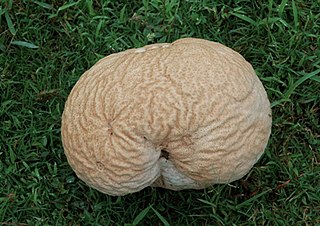
Calvatia is a genus of puffball mushrooms that includes the spectacular giant puffball C. gigantea. It was formerly classified within the now-obsolete order Lycoperdales, which, following a restructuring of fungal taxonomy brought about by molecular phylogeny, has been split; the puffballs, Calvatia spp. are now placed in the family Agaricaceae of the order Agaricales.

Nectria is a genus of Ascomycete fungi. They are most often encountered as saprophytes on decaying wood but some species can also occur as parasites of trees, especially fruit trees and a number of other hardwood trees. Some species are significant pests causing diseases such as apple canker, Nectria twig blight, and coral spot in orchards.

Frederick Tom Brooks CBE FRS was an English botanist and Professor of Botany at the University of Cambridge.

Erechtites is a genus of flowering plants in the daisy family known commonly as fireweeds or burnweeds. They are native to the Americas and Australia, but some species are widely distributed weeds.

Calostoma is a genus of 29 species of gasteroid fungi in the suborder Sclerodermatineae. Like other gasteroid fungi, Calostoma do not have the spore discharge mechanism associated with typical gilled fungi (ballistospory), and instead have enclosed spore-bearing structures. Resembling round puffballs with raised, brightly colored spore openings (ostioles), elevated on a thick, gelatinous stalks, species have been collected in regions of deciduous, temperate, tropical or subtropical forests. Their distribution includes eastern North America, Central America, Asia, and Australasia. The common name given to some species, "prettymouth", alludes to the brightly colored raised openings (ostioles) that may somewhat resemble lips. Other common names include "hotlips" and "puffball in aspic".

Pseudocolus fusiformis is a stinkhorn mushroom in the Phallaceae, a family well known for a remarkable range of fruit body types. It is the most widely distributed member of the genus Pseudocolus and has been found in the United States, Australia, Japan, Java, and the Philippines. It is commonly known as the stinky squid, because of its fetid odor, and its three or four upright "arms" which are connected at the top. The malodorous smell comes from the dark greenish slimy gleba covering the inside faces of the arms, and attracts insects that help to disperse the spores.

Pseudocolus is a genus of fungi in the stinkhorn family. The fruit bodies have three or four simple arms that are initially joined at the tip, but often break apart. The tips of the arms are covered with a slimy, foul-smelling gleba, which attracts insects that help disperse the spores. The genus contains three species: the type Pseudocolus fusiformis, P. garciae, similar in appearance to the type but with a pinkish to red, rather than orange color, and P. grandis, found in India.
Roseograndinia is a fungal genus in the family Phanerochaetaceae. It is a monotypic genus, containing the single crust fungus species Roseograndinia rosea, recorded from tropical east Africa and from New Zealand.

Arachnion is a genus of gasteroid fungi in the family Agaricaceae.

Disciseda is a genus of gasteroid fungi in the family Agaricaceae. It is a widely distributed genus that is prevalent in arid zones. Disciseda was circumscribed by mycologist Vassiliĭ Matveievitch Czernajew in 1845.
Secotium is a genus of fungi in the family Agaricaceae. The members of this genus are closely related to ordinary Agaricus mushrooms, but do not open out in the usual way; this has given rise to the term "secotioid" for such mushrooms in general. They are thought to form an evolutionary link between agarics and gasteroid fungi. Secotium is a widespread genus, with species that are predominantly found in warm and arid regions.

Irpex is a genus of corticioid fungi in the order Polyporales. Species produce fruit bodies that grow as a crust on the surface of dead hardwoods. The crust features an irpicioid spore-bearing surface, meaning it has irregular and flattened teeth. Irpex is distinguished from the similar genera Junghuhnia and Steccherinum by the simple septa found in the generative hyphae.

Coriolopsis is a genus of fungi in the family Polyporaceae. It was circumscribed by American mycologist William Alphonso Murrill in 1905. The genus is cosmopolitan, with most species in tropical areas. The generic name combines the name Coriolus with the Ancient Greek word ὄψις ("appearance").

Favolus, or honeycomb fungus, is a genus of fungi in the family Polyporaceae. The fruit bodies of Favolus species are fleshy with radially arranged pores on the underside of the cap that are angular and deeply pitted, somewhat resembling a honeycomb.

The Gallaceaceae are a family of fungi in the order Hysterangiales, containing species found in Australia and New Zealand. The family contains three genera and 16 species.

Podoserpula is a genus of fungi in the family Amylocorticiaceae. The genus contains six species including the type species, P. pusio, commonly known as the pagoda fungus. Species of the genus Podoserpula produce fruit bodies consisting of up to a dozen caps arranged in overlapping shelves, attached to a central axis. Its unique shape is not known to exist in any other fungi. The genus is known to occur in Australia and New Zealand, Venezuela, Madagascar, and New Caledonia.

Ustilaginoidea is a genus of fungi in the family Clavicipitaceae. The genus contains 19 species. Ustilaginoidea was circumscribed by German botanist Julius Oscar Brefeld in 1895, with Ustilaginoidea oryzae assigned as the type species. Ustilaginoidea virens causes the disesase known alternatively as rice false smut, pseudosmut, or green smut.
Nothocastoreum is a fungal genus in the Mesophelliaceae family. The genus is monotypic, containing the single truffle-like species Nothocastoreum cretaceum, found in Australia.
Ernst Georg Pritzel was a German botanist.














